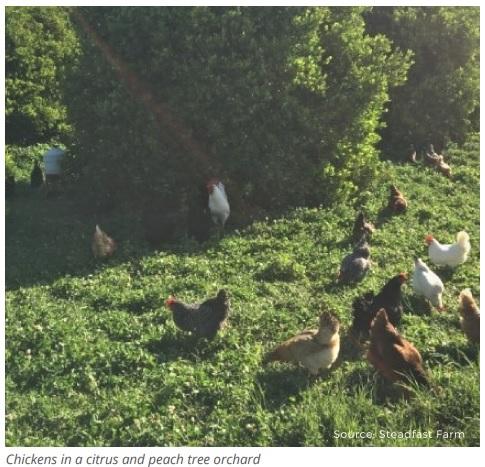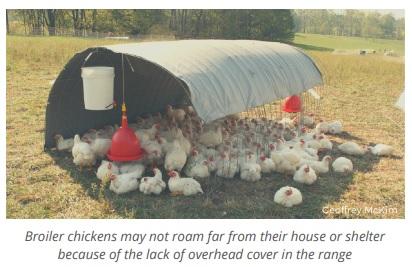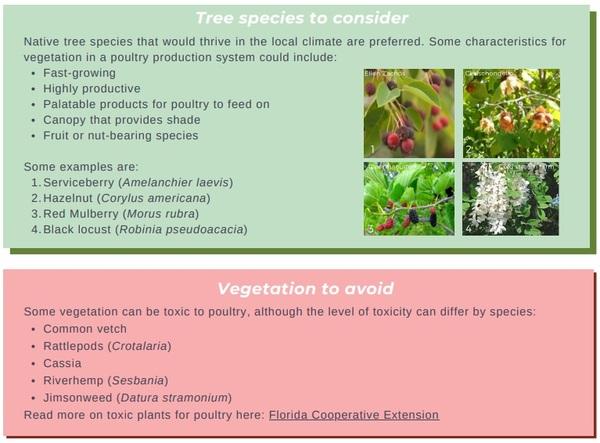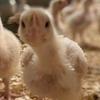Silvopasture-based poultry production


- Global Animal Partnership step 3 and up
- Certified Humane free-range and (seasonal) pasture-raised
- American Humane certified free-range and pasture-raised




- Medium to long-term investment required. Income from vegetation could take a long time, especially if timber will be harvested
- Vegetation management adds labor (thus costs)
- Poultry may experience ground predation if the fencing is not managed appropriately. Electric fences would be sufficient to deter ground predators. Chickens do need to be kept indoors at night
- There's little known about how vegetation impacts the chances of disease transmission between wild birds and poultry. Trees and shrubs will deter some wild birds like water fowl, which are potential carriers of Avian Influenza and Newcastle Disease (Sanchez et al 2016).
- Silvopasture supports chickens to express their natural behaviors such as foraging, sunbathing, and dustbathing.
- Trees provide shade and help to minimize thermal stress.
- Chickens can feed on forages, insects, and fallen tree fruits.
- Due to increased activity in the pasture, chickens may experience fewer leg and foot health issues.
- Silvopasture can be developed on most land types. Planting trees in a row in the existing pasture is one way of developing silvopasture. In the case of existing forests, it can be developed by thinning and pruning some older trees.
- Producers need to be mindful of selecting suitable tree species for long-term harvest and leguminous forages that could be beneficial for both birds and people.
Chedzoy, B. (2015). Creating quality silvopasture from wooded area. On Pasture.
Collias, N. E., & Collias, E. C. (1967). A field study of the red jungle fowl in north-central India. The Condor, 69(4), 360-386.
Fike, J. et al. (2017). Creating Silvopastures: Some Considerations When Planting Trees in Pastures. Virginia Cooperative Extension.
Fike, J. et al. (2016). Defining Silvopastures: Integrating Tree Production With Forage-Livestock Systems for Economic, Environmental, and Aesthetic Outcomes. Virginia Cooperative Extension.
Fike, J., et al. (2016). Creating Silvopastures: Some Considerations When Thinning Existing Timber Stands. Virginia Cooperative Extension.
Gabriel, S. (2018). Six key principles for a successful silvopasture. Cornell University.
Gantz, A. (2016). Pasture poultry producers can benefit from silvopasture. Wattagnet.
Hegelund, L. et al., (2005). Use of the range area in organic egg production systems: effect of climatic factors, flock size, age, and artificial cover. British poultry science, 46(1), 1-8.
Sanchez, S., et al. (2016). Microbiological hazards of wild birds and free-range chickens. In Food Safety Risks from Wildlife (pp. 89-130).
Shrestha et al., (2004). Exploring the potential for silvopasture adoption in south-central Florida: an application of SWOT–AHP method. Agricultural Systems, 81(3), 185-199.
Stadig, L. et al., (2017). Effect of free-range access, shelter type, and weather conditions on free-range use and welfare of slow-growing broiler chickens. Applied Animal Behaviour Science, 192, 15-23.
Thanks for coming up with this interesting idea and article.
At this point, I guess it is important to stress that, on the one hand, we create better conditions for animal welfare, reduce stress, cannibalism, some metabolic problems, including carcass alterations, leg problems, wooden breast syndrome (in the case of broilers). On the other hand, we significantly increase the risk of bacterial (salmonella) and viral (influenza) infection diseases, given that the birds will be exposed to all the challenges of the environment, including contact with insects, wild birds and wild animals. Due to the constant contact with the soil, there is a much greater probability of parasitic infections, which will force the greater use of anthelmintics.
However, for small properties it is a system to be considered.














.jpg&w=3840&q=75)